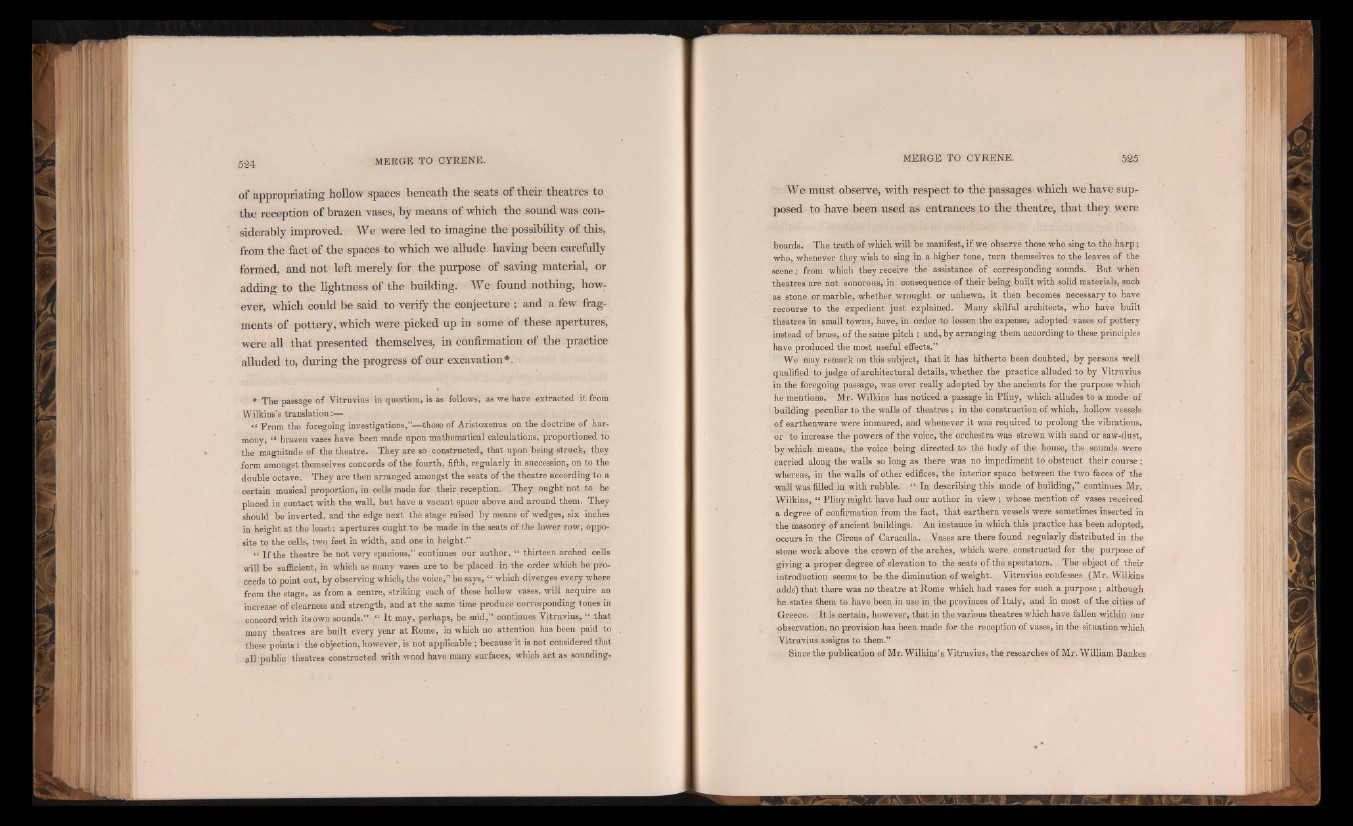
of appropriating hollow spaces beneath the seats of their theatres to
the reception of brazen vases, by means of which the sound was considerably
improved. We were led to imagine the possibility of this,
from the fact of the spaces to which we allude having been carefully
formed, and not left merely for the purpose of saving material, or
adding to the lightness of the building. We found nothing, howr
ever, which could be said to verify the conjecture ; and a few fragments
of pottery, which were picked up in some of these apertures,
were all that presented themselves, in confirmation of the practice
alluded to, during the progress of our excavation*.
* The passage of Vitruvius in question, is as follows, as we have extracted it from
Wilkins’s translation
“ From the foregoing investigations,”—those of Aristoxenus on the doctrine of harmony,
“ brazen vases have been made upon mathematical calculations, proportioned to
the magnitude of the theatre. They are so constructed, that upon being struck, they
form amongst themselves concords of the fourth, fifth, regularly in succession, on to the
double octave. They are then arranged amongst the seats of the theatre according to a
certain musical proportion, in cells made for their reception. They ought not to be
placed in contact with the wall, but have a vacant space above and around them. They
should be inverted, and the edge next the stage raised by means of wedges, six inches
in height at the least: apertures ought to be made in the seats of the lower row, opposite
to the cells, two feet in width, and one in height.”
P If the theatre be not very spacious,” continues our author, “ thirteen arched cells
will be sufficient, in which as many vases are to be placed in the order which he proceeds
td point out, by observing which, the voice,” he says, “ which diverges every where
from the stage, as from a centre, striking each of these hollow vases, will acquire an
increase of clearness and strength, and at the same time produce corresponding tones in
concord with its own sounds.” £t I t may, perhaps, be said,” continues Vitruvius, “ that
many theatres are built every year at Rome, in which no attention has been paid to
these points : the objection, however, is not applicable ; because it is not considered that
all public theatres constructed with wood have many surfaces, which act as sounding-
We must observe* with respect to the passages which we have supposed
to have been used as entrances to the theatre, that they were
boards. The truth of. which will be manifest, if we observe those who sing to thé harp ;
who, whenever they wish to sing in a higher tone, turn themselves to the leaves of the
scene; from which they receive the assistance of corresponding sounds. But when
theatres are not sonorous, in consequence.of their being built with solid materials, such
as stone or marble, whether wrought or unhewn, it then becomes necessary to have
recourse to the expedient just explained. Many skilful architects, who have built
théâtres in small towns, have, in order to lessen the expense, adopted vases pf pottery
instead of brass, of the saine pitch ; and, by arranging them according to these principles
have produced the most useful effects.”
We may remark on this subject, that it has hitherto been doubted, by persons well
qualified to judge of architectural details, whether the practice alluded to by Vitruvius
in the foregoing passage, was ever really adopted by the ancients for the purpose which
he mentions. Mr. Wilkins has noticed a passage in Pliny, which alludes to a mode of
building peculiar to the walls of theatres ; in the construction of which, hollow vessels
of earthenware were immured, and whenever it was required to prolong the vibrations,
or to increase the powers of the voice, the orchestra was strewn with sand or saw-dust,
by which means, the voice being directed to the body of the house, the sounds were
carried along the walls so long as there was no impediment topbstruct their course ;
whèreas, in the walls of other edifices, the interior space between the two faces of the
wall was filled in with rubble, f “ In describing this ¡mode of building,” continues Mr.
’ Wilkins, “ Pliny might have had our author in view ; whose mention of vases received
a degree of confirmation from the fact, that earthern vessels were sometimes inserted in
the masonry of ancient buildings. An instance in which this practice has been adopted,
occurs in the Circus of Caracalla. Vases are there found regularly distributed in the
stone work above the crown of the arches, which were, constructed for the purpose of
giving a proper degree of elevation to the seats of the spectators. The object of their
introduction seems to be the diminution of weight. Vitruvius confesses (Mr. Wilkins
adds) that there was no theatre at Rome which had vases for such a purpose ; although
he. states them to have been in use in the provinces of Italy, and in most of the cities of
Greece.. It is certain, however, that in the various theatres which have fallen within our
observation, no provision has been made for the reception of vases, in the-situation which
Vitruvius assigns to them.”
Since the publication of Mr. Wilkins’s Vitruvius, the researches of Mr. William Bankes